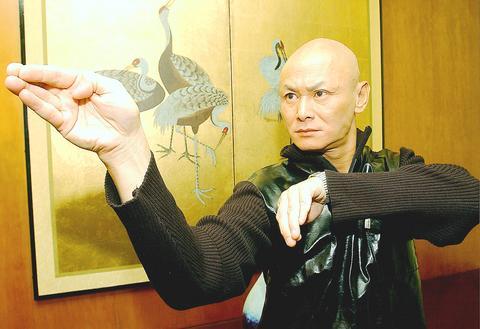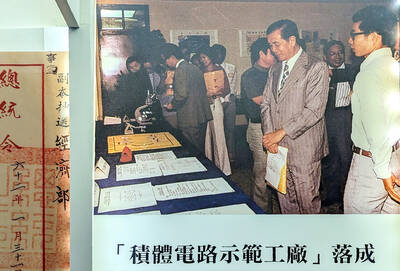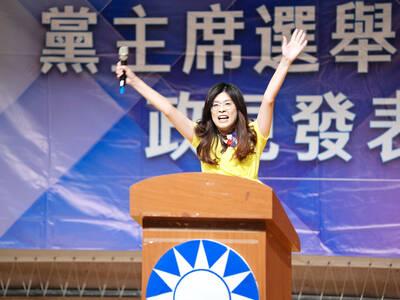Gordon Liu (
Taipei Times: How did Quentin Tarantino talk to you into making the movies?
Liu: When I was told about Quentin's interest in working with me, I told his producer "tell him that I don't know him." When we met in Shanghai, I wore a Chinese suit in order to be formal. I did not expect him to appear in a Chinese suit also! And the first word he greeted me with was shi-fu! (

PHOTO: TAIPEI TIMES
TT: Why are there two roles? Was it yours or Tarantino's idea to have Pai Mei fondling his beard a lot?
Liu: Originally, my role was just Johnny Mo and Quentin wanted to play Pai Mei himself because he is so obsessed with such a vintage character. But when he was in make-up and asked my opinion, I told him, "You look like a Santa Claus, not a martial-arts master." He didn't play the role, instead he did Pai Mei's voice for the US and European version of the movie. It was my idea to make the comic gesture of Pai Mei stroking his beard. It was a different character compared with Johnny Mo. Being Mo the emphasis was on the actions and your expression had to be fierce. But Pai Mei is a role with more humor, he is a softer character (though he is strict with Uma Thurman's character), so the gesture was natural for me.
TT: What was it like to act in the fighting scenes with Uma Thurman?
Liu: If I were her, I would not have taken the two movies. She was punched a lot and slammed against the ground so many times in the movie. During the shooting, in Beijing, she had just given birth to a baby. For me, I've practiced martial arts for decades. But she was trained only for a few months and flew all the way to Beijing to shoot the fighting scenes. Actually, in the beginning, she only fought me in the air, maybe out of respect, until I said to her "Come on, hit me!" After that she had a killer's eyes when she fought with me.
TT: Was that real kung fu in the movie? The Eagle Foot style (
Liu: Of course. The scene when Thurman and I are practicing kung fu together in a cartoon format was the real Tiger-Crane style. It is one of the most famous kung fu styles of my martial arts clan, the Hung Gar style kung fu (洪拳). Quentin is such a fan of the Tiger-Crane style and he wanted me to display it once again on the big screen. As for the Eagle-Feet style, this was a style that contrasted well with the Tiger-Crane style. Actually both these two styles do not belong to Shaolin, or the legendary Pai Mei in history books. Quentin just did mix-and-match for the fun of it.
TT: Being a martial artist, a stuntman and an action actor for decades, how different is real kung fu from what we see in the movies?
Liu: For me, in a movie, you need not just the real kung fu to make believe, but you also have to be able to deliver the plot through the actions. That is the hard part. For a movie you have to express physical beauty in the fighting choreography, and also in your facial expressions. You have to fit in with the atmosphere and take on the personality of a role in relation to an opponent. I remember the most difficult scene in Kill Bill was a fight with Uma Thurman standing on the verge of a banister. I have to make several spins in attacking, while at the same time making my gestures beautiful and convey a killer's spirit toward Thurman. At the same time I had to be careful not to fall from the two-story building!
TT: How did it feel to work in a Hollywood movie?
Liu: It was luxurious, very comfortable. The division of labor is very clear and well-organized. You take enough breaks after a working day. It was much less hectic than in Hong Kong. I'm very honored, as a Chinese actor, to have played a role in both movies and I have to be thankful to Quentin, who has brought my clan's martial arts to the world.
TT: Have you been practicing kung-fu regularly, outside of the movies?
Liu: Yes, every day. I practice kung fu for my health. I can do without making movies but not without kung fu.
TT: What is your next project?
Liu: I am doing a martial-arts TV drama, about my great grand master Wong Fei-hong (黃飛鴻), and another period drama after that. Both will be shot in China.

Oct. 27 to Nov. 2 Over a breakfast of soymilk and fried dough costing less than NT$400, seven officials and engineers agreed on a NT$400 million plan — unaware that it would mark the beginning of Taiwan’s semiconductor empire. It was a cold February morning in 1974. Gathered at the unassuming shop were Economics minister Sun Yun-hsuan (孫運璿), director-general of Transportation and Communications Kao Yu-shu (高玉樹), Industrial Technology Research Institute (ITRI) president Wang Chao-chen (王兆振), Telecommunications Laboratories director Kang Pao-huang (康寶煌), Executive Yuan secretary-general Fei Hua (費驊), director-general of Telecommunications Fang Hsien-chi (方賢齊) and Radio Corporation of America (RCA) Laboratories director Pan

The classic warmth of a good old-fashioned izakaya beckons you in, all cozy nooks and dark wood finishes, as tables order a third round and waiters sling tapas-sized bites and assorted — sometimes unidentifiable — skewered meats. But there’s a romantic hush about this Ximending (西門町) hotspot, with cocktails savored, plating elegant and never rushed and daters and diners lit by candlelight and chandelier. Each chair is mismatched and the assorted tables appear to be the fanciest picks from a nearby flea market. A naked sewing mannequin stands in a dimly lit corner, adorned with antique mirrors and draped foliage
The consensus on the Chinese Nationalist Party (KMT) chair race is that Cheng Li-wun (鄭麗文) ran a populist, ideological back-to-basics campaign and soundly defeated former Taipei mayor Hau Lung-bin (郝龍斌), the candidate backed by the big institutional players. Cheng tapped into a wave of popular enthusiasm within the KMT, while the institutional players’ get-out-the-vote abilities fell flat, suggesting their power has weakened significantly. Yet, a closer look at the race paints a more complicated picture, raising questions about some analysts’ conclusions, including my own. TURNOUT Here is a surprising statistic: Turnout was 130,678, or 39.46 percent of the 331,145 eligible party

The election of Cheng Li-wun (鄭麗文) as chair of the Chinese Nationalist Party (KMT) marked a triumphant return of pride in the “Chinese” in the party name. Cheng wants Taiwanese to be proud to call themselves Chinese again. The unambiguous winner was a return to the KMT ideology that formed in the early 2000s under then chairman Lien Chan (連戰) and president Ma Ying-jeou (馬英九) put into practice as far as he could, until ultimately thwarted by hundreds of thousands of protestors thronging the streets in what became known as the Sunflower movement in 2014. Cheng is an unambiguous Chinese ethnonationalist,